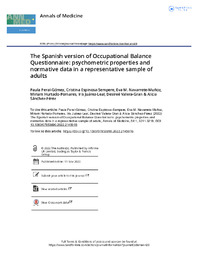Please use this identifier to cite or link to this item:
https://hdl.handle.net/11000/34900Full metadata record
| DC Field | Value | Language |
|---|---|---|
| dc.contributor.author | Peral-Gómez, Paula | - |
| dc.contributor.author | Espinosa-Sempere, Cristina | - |
| dc.contributor.author | Navarrete-Muñoz, Eva María | - |
| dc.contributor.author | Hurtado-Pomares, Miriam | - |
| dc.contributor.author | Juárez Leal, Iris | - |
| dc.contributor.author | Valera-Gran, Desireé | - |
| dc.contributor.author | Sánchez-Pérez, Alicia | - |
| dc.contributor.other | Departamentos de la UMH::Patología y Cirugía | es_ES |
| dc.date.accessioned | 2025-01-18T09:24:26Z | - |
| dc.date.available | 2025-01-18T09:24:26Z | - |
| dc.date.created | 2022-11-11 | - |
| dc.identifier.citation | Ann Med . 2022 Dec;54(1):3211-3218 | es_ES |
| dc.identifier.issn | 3211–3218 | - |
| dc.identifier.uri | https://hdl.handle.net/11000/34900 | - |
| dc.description.abstract | Background: The Occupational Balance Questionnaire (OBQ) is an instrument that assesses occupational balance (OB). It has been transculturality adapted and validated in different countries, showing adequate psychometric properties. To date, no general population-based cut-off points for OB have been developed. Objective: To assess the psychometric proprieties of the Spanish version OBQ (OBQ-E) and to estimate reference norms and the cut-off for OBQ-E in a representative sample of Spanish adults. Materials and methods: A total of 797 adults were included in this validity study. Internal consistency, intra and test-retest reliability of OBQ-E were examined. To obtain the convergent validity and the divergent validity, the Satisfaction with Life Scale (SLS) and the Hospital Anxiety and Depression Scale (HAD) were used respectively, compared with OBQ-E. To determine extreme and moderate disturbed OB stratified by age, sex, and educational level were used the 5 and 15% percentiles of OBQ-E. Results: The OBQ-E showed good internal consistency (a-Cronbach ¼ 0.87), intraclass reliability (ICC ¼ 0.87), and test-retest reliability (rho ¼ 0.83). Convergent (SLS) and divergent (HAD) validity were moderate (rho ¼ 0.39 and rho¼ 0.46, respectively). The lowest extreme disturbed OB cut-off point in men (17.2) and in women (24) appeared at the primary education level, under 40 years of age (men) and 40–65 years of age (women). Conclusions: The OBQ-E presents adequate psychometric properties, and its normative data can be used as a reference to assess and monitor the occupational balance in the general Spanish population. | es_ES |
| dc.format | application/pdf | es_ES |
| dc.format.extent | 9 | es_ES |
| dc.language.iso | eng | es_ES |
| dc.publisher | Taylor&Francis | es_ES |
| dc.rights | info:eu-repo/semantics/openAccess | es_ES |
| dc.rights | Attribution-NonCommercial-NoDerivatives 4.0 Internacional | * |
| dc.rights.uri | http://creativecommons.org/licenses/by-nc-nd/4.0/ | * |
| dc.subject | occupational balance questionnaire | es_ES |
| dc.subject | population normative data | es_ES |
| dc.subject | psychometric properties | es_ES |
| dc.title | The Spanish version of Occupational Balance Questionnaire: psychometric properties and normative data in a representative sample of adults | es_ES |
| dc.type | info:eu-repo/semantics/article | es_ES |
| dc.relation.publisherversion | 10.1080/07853890.2022.2145016 | es_ES |

View/Open:
The Spanish version of Occupational Balance Questionnaire psychometric properties and normative data in a representative sample of adults.pdf
1,79 MB
Adobe PDF
Share:
.png)
